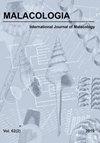A New Species of the Genus Bunnya H. B. Baker, 1942 (Helicoidea) from MÉXico
IF 1
4区 生物学
Q4 ZOOLOGY
引用次数: 1
Abstract
ABSTRACT We describe a new helicoidean semi-slug based on morphological and molecular evidence. The new species belongs to the genus Bunnya and is described from a small agricultural area in Zinacantepec, San Juan de las Huertas, México. The genus Bunnya is externally similar to Xanthonyx, another Helicoidea genus; both genera have similar shell and body form, and both have a tail horn. Internally, Bunnya is similar to Humboldtiana, since both have dart-sacs (3 in Bunnya, 3−4 in Humboldtiana) surrounding the vagina, two dart-bulbs associated with each dart sac, and a gland number similar to the dart-sacs number. Four adult specimens of Bunnya metli n. sp. were dissected and compared with the two described species: B. bernardinae from Cuajimalpa, México City, and B. naranjoe from Sierra de Manantlan, Jalisco. Bunnya metli n. sp. is characterized by: very closely-spaced radial riblets (about 23 per mm) crossed by fine spiral wavy threads on the embryonic whorls; unfused glands inserted on the vagina above the dart-sacs and only one dart per sac; a short, swollen penis with a large spherical verge about half the penis size; an elongated bursa copulatrix with a slight constriction in the middle; a long bursa copulatrix duct; and dart sacs with a muscular pad within the vaginal lumen, surrounding the basal part of the genitalia. We performed a phylogenetic analyses using data from fragments of 16S rRNA mtDNA and 28S rRNA genes from one of the collected specimens, as well as other helicoidean sequences from GenBank. Our analyses support the membership of Bunnya metli n. sp. in Xanthonychidae. This suggests that the taxonomic position of Bunnya in Humboldtianidae or Xanthonychidae warrants reevaluation.Bunnya H.B.Baker属一新种,1942(Helicoidea),来自墨西哥
摘要基于形态学和分子证据,我们描述了一种新的螺旋体半段塞。该新种属于Bunnya属,描述于墨西哥圣胡安德拉斯韦尔塔斯Zinacantepec的一个小农业区。Bunnya属在外表上与另一个Helicoidea属Xanthonyx相似;这两个属的外壳和体型相似,都有一个尾角。从内部来看,Bunnya与Humboldtiana相似,因为两者的阴道周围都有镖囊(Bunnya有3个,Humboldiana有3−4个),每个镖囊有两个镖球,腺体数量与镖囊数量相似。对Bunnya metli n.sp.的四个成年标本进行了解剖,并与所描述的两个物种进行了比较:来自墨西哥城Cuajimalpa的B.bernardinae和来自哈利斯科州Sierra de Manantlan的B.naranjoe。Bunnya metli n.sp.的特征是:胚胎轮生上由细螺旋波状线交叉的非常紧密间隔的径向肋(约每毫米23条);未融合的腺体插入阴道飞镖囊上方,每个飞镖囊只有一个;短而肿的阴茎,有一个大的球形边缘,大约是阴茎大小的一半;一个细长的交配囊,中间有一个轻微的收缩;一个长长的交配囊导管;在阴道内腔内,围绕生殖器基部的带有肌肉垫的镖囊。我们使用来自一个采集标本的16S rRNA mtDNA和28S rRNA基因片段的数据以及来自GenBank的其他螺旋体序列进行了系统发育分析。我们的分析支持Bunnya metli n.sp.在黄杨科中的成员资格。这表明Bunnya在洪堡科或黄甲科中的分类地位值得重新评估。
本文章由计算机程序翻译,如有差异,请以英文原文为准。
求助全文
约1分钟内获得全文
求助全文
来源期刊

Malacologia
生物-动物学
CiteScore
2.00
自引率
0.00%
发文量
15
审稿时长
3 months
期刊介绍:
Malacologia publishes papers on all groups of the Mollusca. Malacologia specializes in publishing long papers and monographic treatments. Complete data are especially appreciated. Papers must be of interest to an international readership. Papers in systematics, ecology, population ecology, genetics, molecular genetics, evolution and phylogenetic treatments are especially welcomed. Also welcomed are letters to the editor involving papers published or issues of import to science of the day.
 求助内容:
求助内容: 应助结果提醒方式:
应助结果提醒方式:


